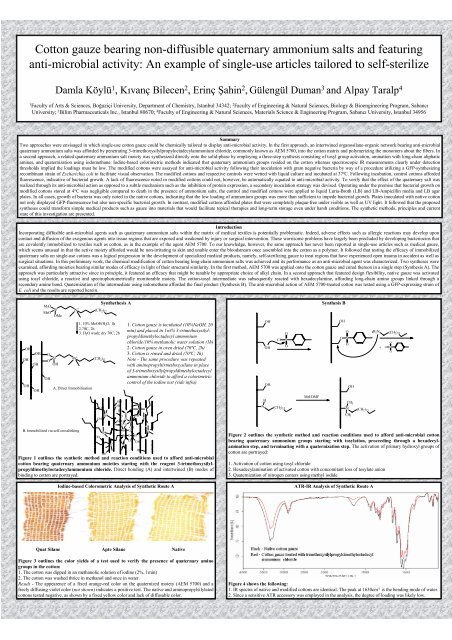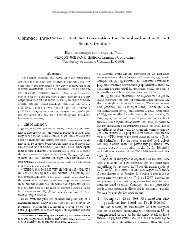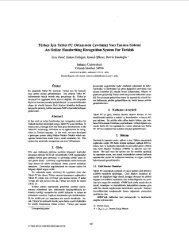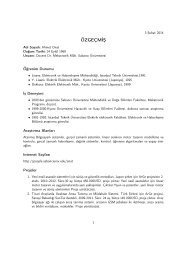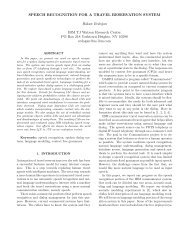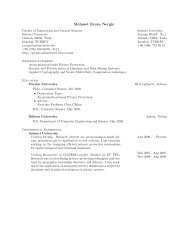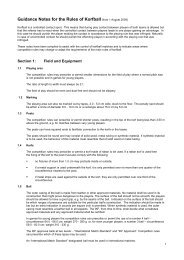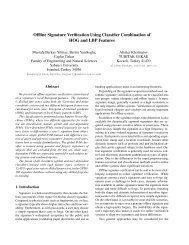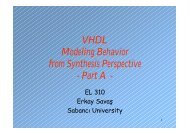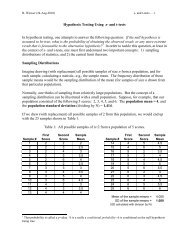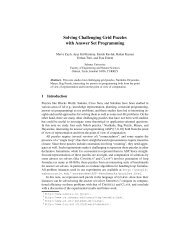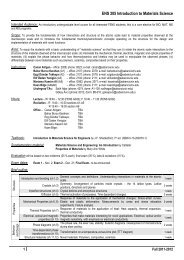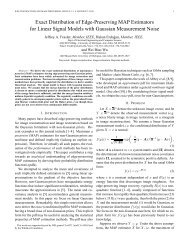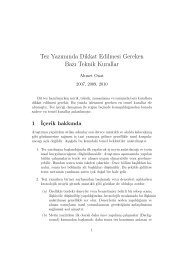Cotton gauze bearing non-diffusible quaternary ammonium salts ...
Cotton gauze bearing non-diffusible quaternary ammonium salts ...
Cotton gauze bearing non-diffusible quaternary ammonium salts ...
Create successful ePaper yourself
Turn your PDF publications into a flip-book with our unique Google optimized e-Paper software.
<strong>Cotton</strong> <strong>gauze</strong> <strong>bearing</strong> <strong>non</strong>-<strong>diffusible</strong> <strong>quaternary</strong> <strong>ammonium</strong> <strong>salts</strong> and featuring<br />
anti-microbial activity: An example of single-use articles tailored to self-sterilize<br />
Damla Köylü 1 , Kıvanç Bilecen 2 , Erinç Şahin 2 , Gülengül Duman 3 and Alpay Taralp 4<br />
1<br />
Faculty of Arts & Sciences, Boğaziçi University, Department of Chemistry, Istanbul 34342; 2 Faculty of Engineering & Natural Sciences, Biology & Bioengineering Program, Sabancı<br />
University; 3 Bilim Pharmaceuticals Inc., Istanbul 80670; 4 Faculty of Engineering & Natural Sciences, Materials Science & Engineering Program, Sabancı University, Istanbul 34956<br />
Summary<br />
Two approaches were envisaged in which single-use cotton <strong>gauze</strong> could be chemically tailored to display anti-microbial activity. In the first approach, an intertwined organosilane-organic network <strong>bearing</strong> anti-microbial<br />
<strong>quaternary</strong> <strong>ammonium</strong> <strong>salts</strong> was afforded by penetrating 3-trimethoxysilylpropyloctadecyl<strong>ammonium</strong> chloride, commonly known as AEM 5700, into the cotton matrix and polymerizing the monomers about the fibers. In<br />
a second approach, a related <strong>quaternary</strong> <strong>ammonium</strong> salt moiety was synthesized directly onto the solid-phase by employing a three-step synthesis consisting of tosyl group activation, amination with long-chain aliphatic<br />
amines, and quaternization using iodomethane. Iodine-based colorimetric methods indicated that <strong>quaternary</strong> <strong>ammonium</strong> groups resided on the cotton whereas spectroscopic IR measurements clearly under detection<br />
thresholds implied the loadings must be low. The modified cottons were assayed for anti-microbial activity following their inoculation with gram negative bacteria by way of a procedure utilizing a GFP-synthesizing<br />
recombinant strain of Escherichia coli to facilitate visual observation. The modified cottons and respective controls were wetted with liquid culture and incubated at 37ºC. Following incubation, control cottons afforded<br />
fluorescence, indicative of bacterial growth. A lack of fluorescence noted in modified cottons could not, however, be automatically equated to anti-microbial activity. To verify that the effect of the <strong>quaternary</strong> salt was<br />
realized through its anti-microbial action as opposed to a subtle mechanism such as the inhibition of protein expression, a secondary inoculation strategy was devised. Operating under the premise that bacterial growth on<br />
modified cottons stored at 4°C was negligible compared to death in the presence of <strong>ammonium</strong> <strong>salts</strong>, the control and modified cottons were applied to liquid Luria-Broth (LB) and LB-Ampicillin media and LB agar<br />
plates. In all cases, growth of bacteria was only noted in the native cottons, indicating that the low loading of <strong>ammonium</strong> groups was more than sufficient to impede bacterial growth. Plates inoculated with native cotton<br />
not only displayed GFP-fluorescence but also <strong>non</strong>-specific bacterial growth. In contrast, modified cottons afforded plates that were completely plaque-free under visible as well as UV light. It followed that the proposed<br />
syntheses could transform simple medical products such as <strong>gauze</strong> into materials that would facilitate topical therapies and long-term storage even under harsh conditions. The synthetic methods, principles and current<br />
state of this investigation are presented.<br />
Introduction<br />
Incorporating <strong>diffusible</strong> anti-microbial agents such as <strong>quaternary</strong> <strong>ammonium</strong> <strong>salts</strong> within the matrix of medical textiles is potentially problematic. Indeed, adverse effects such as allergic reactions may develop upon<br />
contact and diffusion of the exogenous agents into tissue regions that are exposed and weakened by injury or surgical intervention. These worrisome problems have largely been precluded by developing bacteriocins that<br />
are covalently immobilized to textiles such as cotton, as in the example of the agent AEM 5700. To our knowledge, however, the same approach has never been reported in single-use articles such as medical <strong>gauze</strong>,<br />
which seems unusual in that the active moiety afforded would be <strong>non</strong>-irritating to skin and unable enter the bloodstream once assembled into the cotton as a polymer. It followed that testing the efficacy of immobilized<br />
<strong>quaternary</strong> <strong>salts</strong> on single-use cottons was a logical progression in the development of specialized medical products, namely, self-sterilizing <strong>gauze</strong> to treat regions that have experienced open trauma in accident as well as<br />
surgical situations. In this preliminary work, the chemical modification of cotton <strong>bearing</strong> long-chain <strong>ammonium</strong> <strong>salts</strong> was achieved and its performance as an anti-microbial agent was characterized. Two syntheses were<br />
examined, affording moieties <strong>bearing</strong> similar modes of efficacy in light of their structural similarity. In the first method, AEM 5700 was applied onto the cotton <strong>gauze</strong> and cured thereon in a single step (Synthesis A). The<br />
approach was particularly attractive since in principle, it featured an efficacy that might be tunable by appropriate choice of alkyl chain. In a second approach that featured design flexibility, native <strong>gauze</strong> was activated<br />
using tosyl chloride, a reactive and spectrophotometrically monitorable moiety. The cotton-tosyl intermediate was subsequently reacted with hexadecylamine, affording long-chain amino groups linked through a<br />
secondary amine bond. Quaternization of the intermediate using iodomethane afforded the final product (Synthesis B). The anti-microbial action of AEM 5700-treated cotton was tested using a GFP-expressing strain of<br />
E. coli and the results are reported herein.<br />
M 3 O Si<br />
Synthethesis A<br />
Synthesis B<br />
N + (CH 2 ) 12<br />
N +<br />
OH<br />
1. 10% MeOH/H 2 O, 1h 1. <strong>Cotton</strong> <strong>gauze</strong> is incubated (10%NaOH, 20<br />
o<br />
2.70C, 2h<br />
o min) and placed in 1wt% 3-trimethoxysilylpropyldimethyloctadecyl<br />
<strong>ammonium</strong><br />
3. H 2 O wash; dry 70C, 2h<br />
chloride/10% methanolic water solution (1h)<br />
OH<br />
OH<br />
2. <strong>Cotton</strong> <strong>gauze</strong> in oven dried (70ºC, 2h)<br />
OH O 3. <strong>Cotton</strong> is rinsed and dried (70ºC, 2h)<br />
Si N + (CH<br />
O 2 ) 12 Note - The same procedure was repeated<br />
OH OH with aminopropyltirmethoxysilane in place<br />
of 3-trimethoxysilylpropyldimethyloctadecyl<br />
OH<br />
<strong>ammonium</strong> chloride to afford a colorimetric<br />
control of the iodine test (vide infra)<br />
OH<br />
OH<br />
A. Direct Immobilization<br />
OH<br />
OH OH<br />
OH<br />
HO<br />
N +<br />
N + O Si OH<br />
OH<br />
O<br />
Si O Si<br />
O O<br />
MeO OMe<br />
B. Immobilized via self-crosslinking<br />
HO<br />
Si O<br />
Si O Si<br />
O O OH<br />
Si<br />
HO<br />
Figure 1 outlines the synthetic method and reaction conditions used to afford anti-microbial<br />
cotton <strong>bearing</strong> <strong>quaternary</strong> <strong>ammonium</strong> moieties starting with the reagent 3-trimethoxysilylpropyldimethyloctadecyl<strong>ammonium</strong><br />
chloride. Direct bonding (A) and intertwined (B) modes of<br />
binding to cotton are portrayed.<br />
Iodine-based Colorometric Analysis of Synthetic Route A<br />
HO<br />
N +<br />
N<br />
OH<br />
OH<br />
H<br />
OH<br />
O<br />
Cl S<br />
(CH 2) 13<br />
O<br />
MeI/DMF<br />
Figure 2 outlines the synthetic method and reaction conditions used to afford anti-microbial cotton<br />
<strong>bearing</strong> <strong>quaternary</strong> <strong>ammonium</strong> groups starting with tosylation, proceeding through a hexadecylamination<br />
step, and terminating with a quaternization step. The activation of primary hydroxyl groups of<br />
cotton are portrayed:<br />
1. Activation of cotton using tosyl chloride<br />
2. Hexadecylamination of activated cotton with concomitant loss of tosylate anion<br />
3. Quaternization of nitrogen centers using methyl iodide<br />
OH<br />
O<br />
O S<br />
O<br />
OH<br />
+ N<br />
CH 3<br />
CH 3<br />
(CH 2) 13<br />
ATR-IR Analysis of Synthetic Route A<br />
H 2N<br />
-<br />
- O<br />
(CH 2) 13<br />
O<br />
S<br />
O<br />
Quat Silane Apte Silane Native<br />
Figure 3 outlines the color yields of a test used to verify the presence of <strong>quaternary</strong> amino<br />
groups in the cotton:<br />
1. The cotton was dipped in an methanolic solution of iodine (2%, 1min)<br />
2. The cotton was washed thrice in methanol and once in water.<br />
Result - The appearence of a fixed orange-red color on the quaternized moiety (AEM 5700) and a<br />
freely diffusing violet color (not shown) indicates a positive test. The native and aminopropylsilylated<br />
cottons tested negative, as shown by a fixed yellow color and lack of diffusable color.<br />
Figure 4 shows the following:<br />
1. IR spectra of native and modified cottons are identical. The peak at 1630cm -1 is the bending mode of water.<br />
2. Since a sensitive ATR accessory was employed in the analysis, the degree of loading was likely low.
Anti-microbial Efficacy, Results and Discussion<br />
(A) (B) (C) (D) (E) (F) (G)<br />
Figure 6 shows that GPF was expressed on native <strong>gauze</strong> but not AEM 5700-treated <strong>gauze</strong>:<br />
The photographs taken under UV light (in B&W and color) show that treating <strong>gauze</strong> with<br />
trimethoxysilylpropyldimethyloctadecyl <strong>ammonium</strong> chloride at least curbs the expression of GPF in<br />
gram (-) E coli <strong>bearing</strong> the GFP gene. The question remaining to be answered is whether or not E coli<br />
was actually killed by the action of AEM 5700. Inoculation method: <strong>Cotton</strong> was autoclaved for 30 min.<br />
Ampicillin resistant bacterial strain was inoculated with ampicillin (0.1mg /mL) and incubated at 37ºC<br />
with 300 rpm shaking until A = 0.5, then diluted in LB+Amp. Native and modified cottons were put in<br />
liquid media and were incubated either at 4ºC (results not shown) or 37°C (results, vide supra)]<br />
[Photographs: Images were captured using a UVITEC-JAI camera and processed using UVITEC-<br />
UVIPhotoMW Version 10.02 software]<br />
under UV light<br />
(A) (B) (C) (D)<br />
under visible light<br />
A B C D<br />
Figure 7 shows the post-incubation appearance of Luria-Broth Agar plates streaked with native and modified cotton <strong>gauze</strong> under aseptic<br />
conditions. Plates were incubated at 37°C for 24 hours and visualized under visible and UV light to monitor bacterial growth. On the LB agar plate<br />
that was streaked with native cotton <strong>gauze</strong>, growth of GFP producing and <strong>non</strong>-producing bacteria can be followed (A, C). In contrast, no growth was<br />
observed in the case of modified cotton (B, D).<br />
Figure 8 shows under UV light the post-incubation appearance of LB and LBA (100µg/ml<br />
ampicillin) media following inoculation with native and modified cottons<br />
LB and LBA (100µg/ml ampicillin) media (5ml) were inoculated with native and modified cotton. The<br />
tubes were incubated at 37°C with 300 rpm shaking for 24 hours. Bacterial growth in LB (F) and LBA<br />
(G) media that were inoculated with native cotton <strong>gauze</strong> contrasted notably against sterile LB medium<br />
containing a piece of cotton <strong>gauze</strong> (A). LB (B, D) and LBA (C, E) media inoculated with modified cotton<br />
<strong>gauze</strong> showed no bacterial growth.<br />
Conclusions<br />
The <strong>quaternary</strong> amine strategy shows merit in the matter of producing improved<br />
single-use cottons and related self-sterilizing products of medical significance.<br />
References<br />
1. White WC, Monticello RA, Krueger JW, Vandandaele<br />
P. A Comparison of Anti-microbials for the Textile<br />
Industry<br />
2. Hales MG, Sarkin ME, White WC. Anti-microbial<br />
Treatments Part II, Cleaning & Restoration Magazine,<br />
1986.<br />
3. Yamazaki H, Boyd CS. Activation of Rayon/Polyester<br />
Cloth for Protein Immobilization in Methods of<br />
Biotechnology, Vol 1, Immobi-lization of Enzymes and<br />
Cells, GF Bickerstaff Humana Press, NJ.<br />
4. Harlow E, Lane D. Antibodies-Alaboratory Manual,<br />
Cold Spring Harbor Laboratory, Cold Spring Harbor,<br />
NY, pp. 535-536.<br />
5. McLean WFH, Jewers K. Journal of Chromotography,<br />
1972, 74, 297-302<br />
6. Sambrook J, Russell DW. Molecular cloning: A<br />
laboratory manual, 3 rd ed., Cold Spring Harbor<br />
Laboratory Press, NY, 2001.<br />
7. Latlief MA, Goldsmith MT, Friedl JL, Stuart LS, Journal<br />
of Pediatrics 40, 1952, 599-605.<br />
8. http://www.kcom.edu/faculty/chamberlain/website/lects/<br />
bacteria.htm<br />
9. http://microvet.arizona.edu/courses/MIC419/<br />
systemmodules/ infectiousdisease.html<br />
10. http://www.rkm.com.au/cell/bacterial/bacterialimages<br />
Background Material - The Bacterial Wall and Quaternary Ammonium Salts<br />
Figures 9 and 10 illustrate the difference<br />
in wall structure of gram (+) and (-)<br />
bacteria. Gram positive bacteria have a<br />
thick peptidoglycan layer outside their<br />
plasma membrane. In contrast, gram<br />
negative bacteria have a thin<br />
peptidoglycan layer and an outer (lipid<br />
bilayer) lipid membrane (OM) containing<br />
lipopolysaccharide (LPS). Quaternary<br />
<strong>ammonium</strong> <strong>salts</strong> <strong>bearing</strong> long alkyl chains<br />
have the property of disrupting the delicate<br />
cell membrane and therefore do not need<br />
to be absorbed in solution to show their<br />
bactericidal effect.<br />
Figure 9: Gram (+) bacterial wall<br />
Figure 10: Gram (-) bacterial wall


